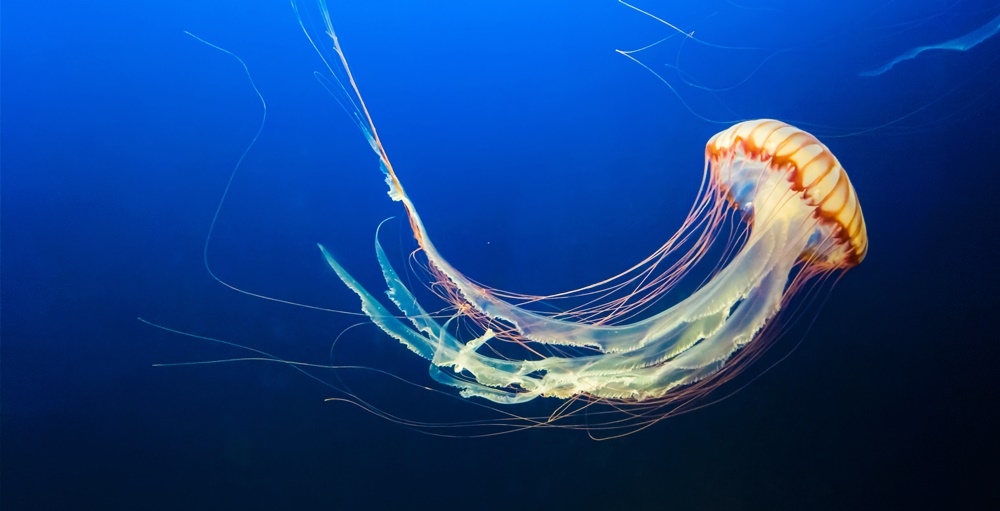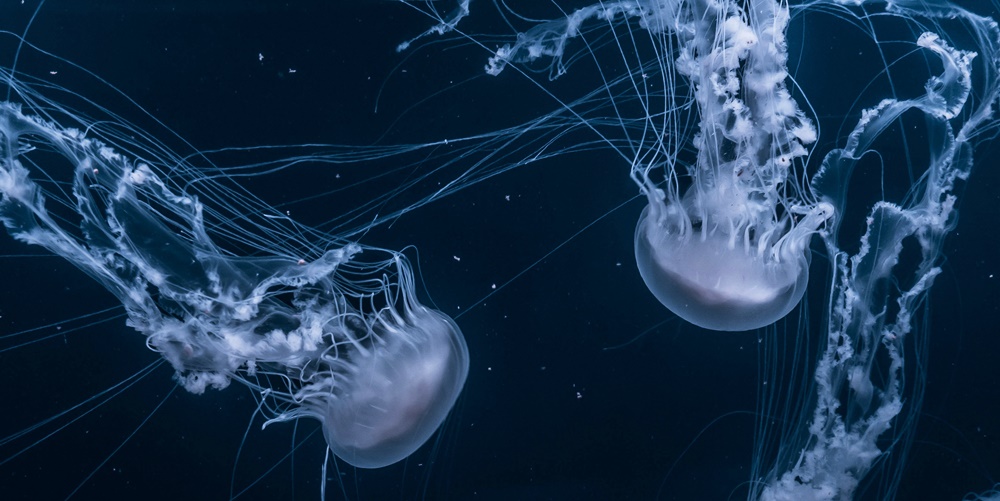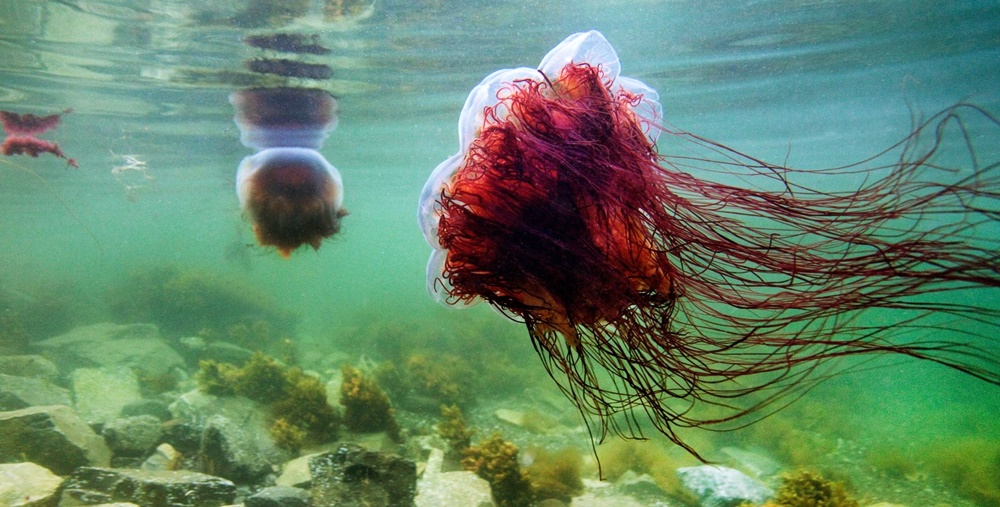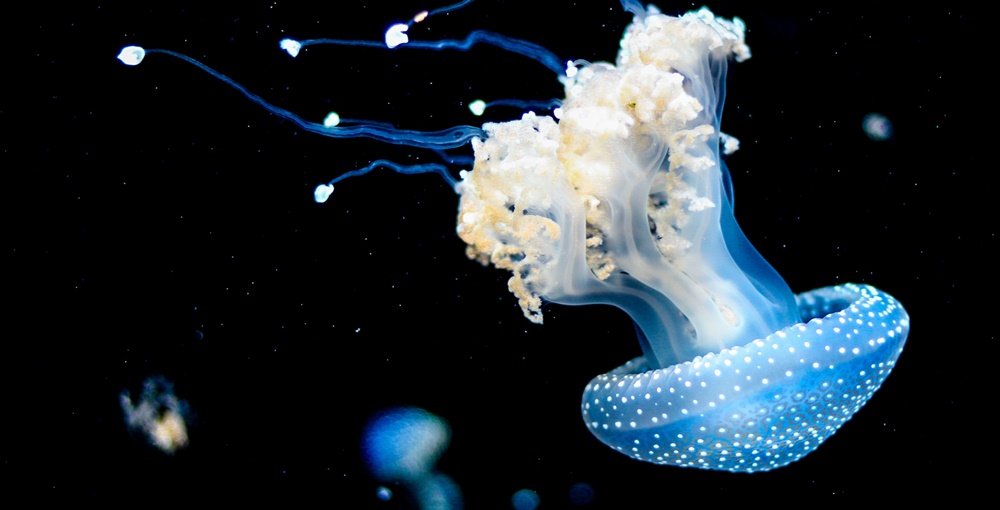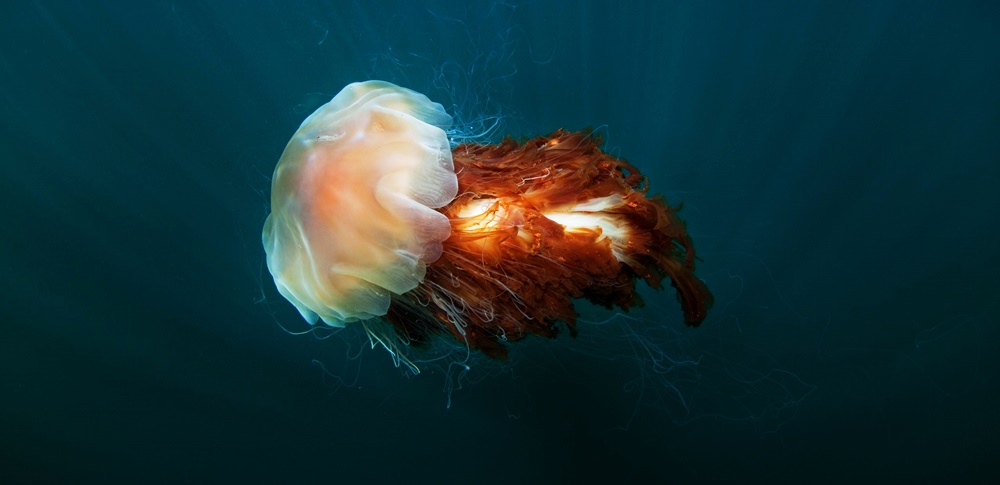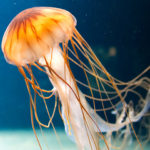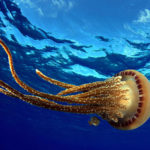Lion’s Mane Jellyfish – Habitat, Facts, Sting, Life Cycle, Diet
Longer Than A Whale – If you’re looking for a good candidate for a sea monster, try the Lion’s Mane jellyfish. This is not your average jellyfish. The Lion’s Mane jellyfish can be big, very big. It’s the largest jellyfish known, although its size depends upon where you find it. The largest Lion’s Mane jellyfish are found in Arctic and sub-Arctic waters. The bell of this jellyfish can reach a diameter of 8 feet and the tentacles can be 100 feet long. It could be a little unnerving to be swimming along and suddenly find a jellyfish swimming beside you that is a great deal bigger than you are. While this creature is not anywhere as large as a whale, if you take the length of the tentacles into account, it is just as long as a Blue whale.
Contents
Habitat
Now let’s talk about the Lion’s Mane Jellyfish habitat. Lion’s Mane Jellyfish can be found in various waters to include the northern Atlantic, northern Pacific, and boreal waters of the Arctic oceans. Although other Jellyfish similar to the Lion’s Mane is found in New Zealand and Australia, the largest Jellyfish rarely moves south beyond 42-degrees latitude.
Your best chance of seeing a Lion’s Mane jellyfish, if you are not out in a boat, is from a pier or dock somewhere along the Pacific Northwest Coast, or along the shorelines of Eastern Canada and New England. The jellyfish swims fairly close to the surface most of the time. The ones found washed up on beaches are usually fairly small, although occasionally someone will come across a Lion’s Mane jellyfish that measures two feet or so in diameter.
Being able to see a Lion’s Mane in the water is simply mesmerizing in that this species is actually beautiful and mysterious but people never want to get near in that it provides a nasty sting. The world’s largest Jellyfish can grow more than seven feet in diameter and the tentacles reach lengths of 120 feet. The first recording of this massive Jellyfish was in 1870 when one washed up on the shore in Massachusetts. Shockingly, the Lion’s Mane is larger than the Blue Whale, which has long been considered the world’s largest animal.
Facts About Lion’s Mane Jellyfish – Interesting and Fun
To show you just how special and unique the largest Jellyfish is, we have provided seven facts about Lion’s Mane Jellyfish. Without a doubt, the Lion’s Mane Jellyfish leaves a lasting impression.
- All Jellyfish stings are painful due to the toxins found in the tentacles but not fatal. The Lion’s Mane species is no different although the degree of pain is more intensified. In fact, the toxins of the largest Jellyfish actually cause severe burns. The Lion’s Mane is considered more dangerous but to date, only a single person has been died from being stung.
- The world’s largest Jellyfish varies in size with those found at lower latitudes being smaller than the Lion’s Mane found further to the north.
- On average, the tentacles of the Lion’s Mane reach 100 feet long and are extremely sticky. These tentacles are found in groups of eight clusters, each consisting of between 65 and 150 tentacles arranged in rows.
- The body of Jellyfish is called the “bell.” For the world’s largest Jellyfish, the bell has eight lobes, which makes it look like an eight-point star. Attached to the bell are colorful arms, which come out from the center portion whereas the tentacles connect to the subumbrella portion of the bell.
- The actual size of the largest Jellyfish is what determines the color. Typically, the largest Lion’s Mane has a bright red to deep purple coloring while the smaller ones are tan or light orange.
- Typically, Jellyfish of all species to include the world’s largest Jellyfish are more commonly seen during the late summer months and into fall. At that time, they are at their largest and because water currents have pushed them closer into shore, people have more visibility.
- Finally, the largest Jellyfish can sexually reproduce in the medusa state but also asexually reproduce in the polyp stage.
Lion’s Mane Jellyfish Sting
Imagine trying to avoid 100 feet or more of stinging tentacles. Fortunately, the sting of the Lion’s Mane jellyfish is rarely lethal, but it can be very uncomfortable to be stung by one. Most people who run afoul of the Lion’s Mane swim into pieces of one along the shoreline or step on tentacles that have washed up on the beach. The jellyfish itself is not a particularly strong swimmer. It moves about by weakly pulsing its bell-shaped body in the general direction it chooses to go. It does not use a jet-engine principle as some other species of jellyfish do to move along in short, rapid bursts. It is in fact a slow, but very graceful swimmer.
Nevertheless, this jellyfish, which is quite beautiful, has a bad reputation thanks to Sir Arthur Conan Doyle. In one of his Sherlock Holmes stories, the Lion’s Mane was actually an instrument of death, and it is admittedly somewhat difficult to imagine a jellyfish that large whose sting is not lethal. Those who are at the greatest risk from the sting of the Lion Mane’s tentacles are often the same people who will have an allergic reaction to bee stings and the stings from other creatures that are not usually harmful to most people. The severity of the sting is usually directly proportional to the number of tentacles one has come into contact with.
Bits And Pieces Are Dangerous Too – The other danger the Lion’s Mane can pose to people is, ironically, due to its fragility. It is easily torn apart, and its tentacles or body parts can be caught up in ropes or lines that are in the water. When pulled into a boat, or onto the shore, the tentacles or body parts, still contain toxins, and can deliver a painful sting when coming into contact with bare skin.
Lion’s Mane Jellyfish Life Cycle and Lifespan
Now let’s talk about the life cycle of Lion’s Mane Jellyfish. The life cycle of this Jellyfish has four stages. The first stage is called a larva, then goes the polyp stage, after that ephyrae, and finally the medusa stage. These four stages make up the life cycle of a jellyfish.
What about the Lion’s Mane Jellyfish lifespan? The largest Jellyfish, as well as other species only lives about one year. New Jellyfish are born in the billions, each being no larger than a single grain of sand. Although most will die as the water becomes warmer, the few that survive to begin to grow although slowly, only reaching approximately six inches in diameter within the first few months.
All Jellyfish to include the Lion’s Mane are pelagic, which means they prefer to stay in open waters in a special zone that is not near the bottom. However, in the last days or weeks of life, Jellyfish move to shallow waters found in sheltered bays.
Lion’s Mane Jellyfish Diet
The largest Jellyfish is appreciated by other sea creatures to include butterfish, harvest fish, prow fish, shrimp, and medusa fish, using this massive floating creature as a place to hide, as well as a reliable food source. The diet of the Lion’s Mane Jellyfish includes smaller fish, moon jellies, ctenophores, and zooplankton.
Both Predator And Prey – The Lion’s Mane jellyfish do not attack people. It feeds mostly on small fish, and tiny zoo-plankton. It will also eat smaller jellyfish that happen to drift too near. On the other hand, certain other jellyfish will eat the Lion’s Mane, a rather large meal, as will various sea birds, sea turtles, and larger fish. One might think that a jellyfish so large would have a hard time avoiding predators, but the species does not appear to be in any way endangered.
If there is one place on the planet where the Lion’s Mane has somewhat feared it is in the waters surrounding Australia. For whatever reason, the sting the Lion’s Man can deliver when encountered in these waters seems to be a little more potent. Although there has only been one death recorded to date, getting tangled up in a large mass of stinging tentacles can be an experience you wouldn’t wish on anyone.
Arctic Lion’s Mane Jellyfish
Bigger In Northern Waters – If you really want to see how big Lion’s Mane jellyfish can grow, head north. The largest specimens, as noted above, are found in Arctic waters. Arctic Lion’s Mane Jellyfish is not a separate species, it’s the same as the Lion’s Mane Jellyfish. But usually, people call this species this way, because the largest ones are found in Arctic waters. The farther south you go, the smaller the species becomes. The color also changes from a dark crimson in northern waters to a much lighter orange in subtropical waters.
Where does the Lion’s Mane get its name? As you probably have guessed, it’s from the appearance of the tentacles. The typical Lion’s Mane has anywhere from 500 to 1,000 tentacles flowing out from its bell-shaped body, and the tentacles very much appear to resemble the mane of a lion, a very long mane of course. You may not always see a close resemblance when the jellyfish is gliding peacefully through the water. It is when one washes up on a beach, more or less intact, that the tentacles surrounding the 8-lobed bell really do resemble the mane of a lion.
Video
In the end, you can watch a video where you can see the Lion’s Mane Jellyfish in action –

